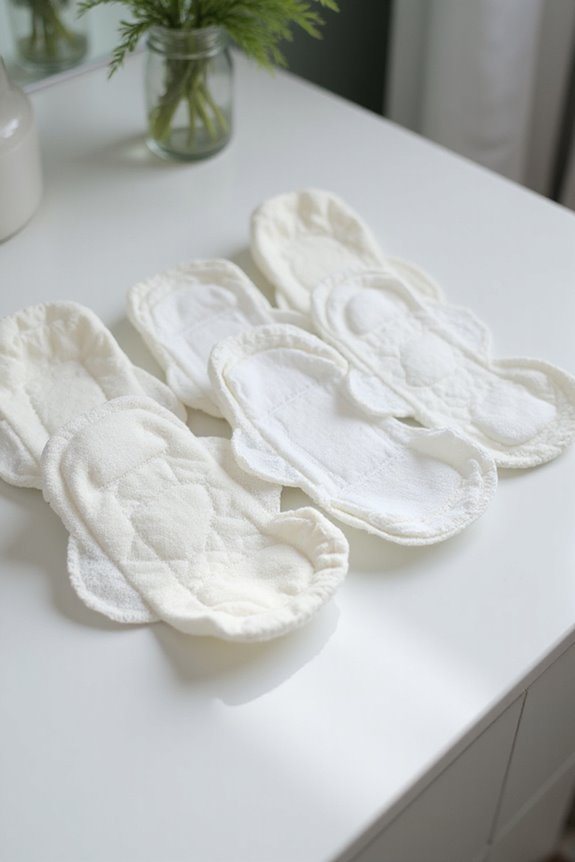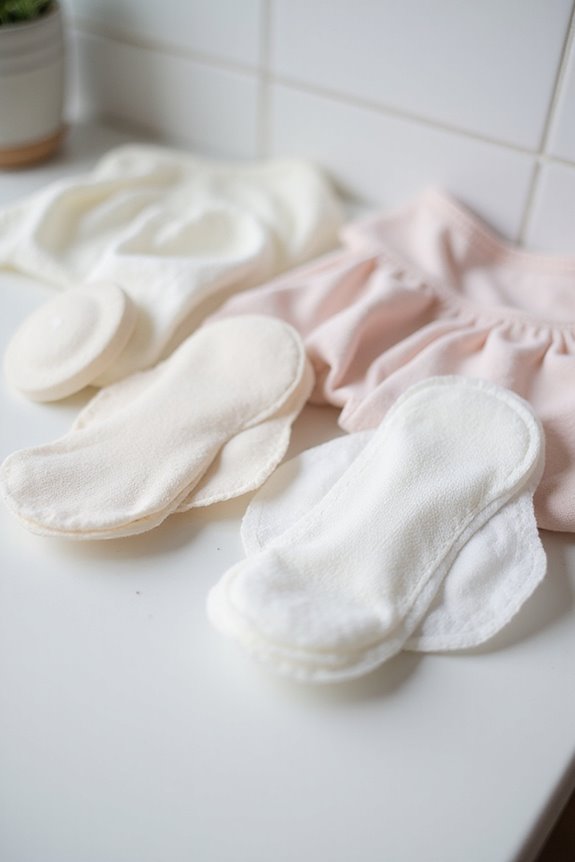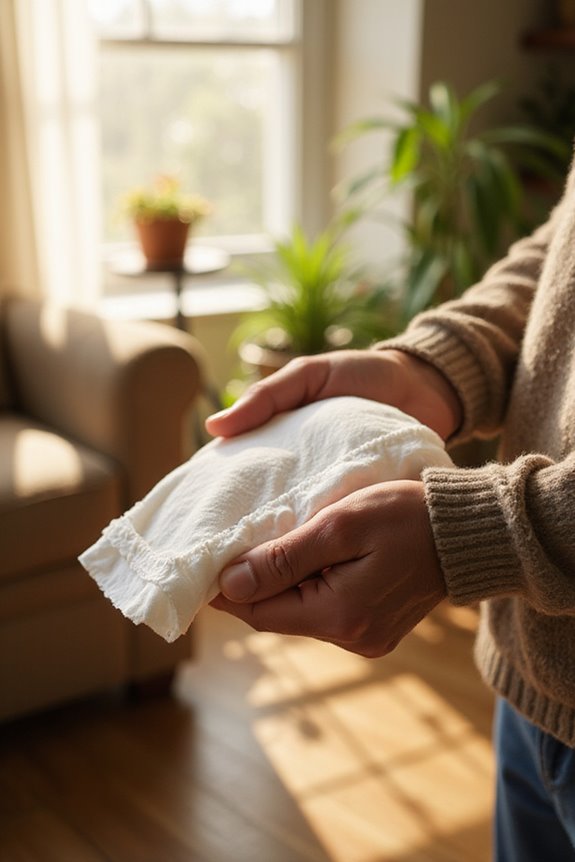Choosing the right absorbency level involves evaluating several factors. First, understand personal menstrual flow, which ranges considerably; tampons vary from 20 mL to 34 mL, while menstrual cups hold 22 mL to 35 mL. For incontinence, identify the type—urinary or faecal—then consider the frequency and volume of leaks. Brand variations also influence effectiveness, with name brands generally offering higher standards. Ideal selection aligns with individual needs and lifestyle factors, encouraging a more informed choice. More insights are available on the specifics.
Key Takeaways
- Assess your menstrual flow characteristics, including volume, intensity, and consistency, to determine your absorbency needs.
- Consider your lifestyle factors, such as physical activity and period duration, which may require different absorbency levels.
- Evaluate any health conditions, like menorrhagia, that necessitate higher absorbency menstrual products.
- Choose products from reputable brands that undergo rigorous absorbency testing for reliability and effectiveness.
- Match the absorbency level of tampons, pads, or cups to your flow intensity, using lighter options for lighter days.
Understanding Absorbency Levels in Menstrual and Incontinence Products
Understanding absorbency levels in menstrual and incontinence products is essential for consumers seeking effective solutions for their needs. Various products exhibit different absorbency capacities, debunking common absorbency myths.
Menstrual Products:
- Tampons: 20 mL to 34 mL
- Pads: 31 mL to 52 mL
- Menstrual Cups: 22 mL to 35 mL
- Menstrual Discs: 40 mL to 80 mL (highest absorbency)
- Period Underwear: 1 mL to 3 mL (lowest absorbency)
Incontinence Products:
- Adult Diapers: Light to heavy absorption
- Incontinence Pads: Varying levels based on leakage
- Incontinence Briefs: More absorbent than pads
Product comparisons reveal substantial differences, influencing consumer choices based on flow and protection needs.
Factors Influencing Your Absorbency Needs

Several factors play an essential role in determining an individual’s absorbency needs when selecting menstrual and incontinence products.
Menstrual Flow Characteristics
- Absorbency requirements vary with menstrual flow volume and intensity, necessitating adjustments throughout the cycle.
- Individual variability in flow consistency and clotting can impact product performance.
Lifestyle Impact
- Physical activity levels influence absorbency needs; active individuals may require products with enhanced leakage protection.
- Longer periods or overnight use typically demand higher absorbency.
Health Considerations
- Conditions like menorrhagia necessitate higher absorbency levels.
- Sensitivity to materials can limit options, while hormonal treatments may affect flow volume. Additionally, absorbency levels can help ensure adequate protection for various situations.
Understanding these factors guarantees informed choices tailored to personal needs, facilitating comfort and confidence.
Brand Variations and Their Impact on Absorbency

Brand variations markedly influence absorbency performance in menstrual products, underscoring the importance of selection.
- Tampax Pearl exhibits superior absorbency compared to generic brands like Equate, which may not meet higher flow needs.
- U by Kotex offers multiple absorbency levels, including regular, super, and super plus, using rayon material for diverse user preferences.
- The Honey Pot focuses on organic cotton options, though limited in absorbency choices.
Brand comparisons reveal that name brands, typically undergoing rigorous absorbency testing, often justify higher costs due to enhanced performance. In contrast, generic brands may utilize similar materials but lack the same effectiveness. Ultimately, the choice of brand markedly impacts the absorbency level and overall menstrual experience, highlighting the necessity of informed decision-making.
Recommendations for Menstrual Product Absorbency Selection

When selecting the appropriate absorbency level for menstrual products, it is essential to contemplate individual flow intensity, as this greatly impacts the effectiveness of the chosen product.
- Tampons: Choose light, regular, or super absorbency based on flow.
- Pads: Select absorbency levels from 31 mL to 52 mL for heavier flow.
- Menstrual Cups: Offer eco-friendly options with absorbencies between 22 mL and 35 mL.
- Menstrual Discs: High absorbency, ranging from 40 mL to 80 mL.
- Period Underwear: Suitable for light days, with absorbency between 1 mL and 3 mL.
Awareness of absorbency myths can aid in making informed product comparisons. Ultimately, understanding personal flow patterns and preferences will lead to ideal product selection, ensuring comfort and effectiveness during menstruation.
Guidelines for Choosing Absorbency in Incontinence Products

Choosing the appropriate absorbency level for incontinence products requires a systematic approach, as various factors influence the effectiveness and comfort of the selected item.
Incontinence Types
- Identify if the incontinence is urinary or faecal.
- For occasional leaks, light absorbency suffices; for frequent leaks, moderate to heavy absorbency is necessary.
Assessing Frequency and Volume
- Higher absorbency is essential for frequent or large-volume leaks.
- Average daily urine output ranges from 27 to 67 oz., with varying bladder capacities.
Lifestyle Considerations
- Active individuals may prefer lighter, discreet options.
- Those with limited mobility need maximum absorbency and secure fit.
Product Materials
– Guarantee breathable materials and appropriate fit to minimize leaks while enhancing comfort. Additionally, selecting products with superior absorbency ensures optimal protection for different needs.
Practical Tips for Optimizing Absorbency Choices
Understanding the nuances of absorbency choices is essential for enhancing comfort and effectiveness in incontinence management.
Practical Testing
- Engage in absorbency testing by sampling different levels during various daily scenarios.
- Track performance during day and night to identify ideal options.
User Feedback
- Actively seek user feedback regarding comfort, confidence, and fit.
- Adjust absorbency levels based on personal experiences and skin condition monitoring.
Lifestyle Consideration
- Consider lifestyle changes, activity levels, and fluid intake when selecting products.
- Combine different designs for day versus night use to maximize protection and satisfaction. Additionally, ensure the selected products have appropriate absorbency levels for your specific leakage severity to enhance overall reliability.
Monitoring and Adjusting Absorbency Over Time
Effective management of absorbency requires continuous monitoring and adjustment to align with changing needs. This process is critical for ensuring ongoing protection and comfort.
Monitoring Tools
- Utilize absorbency sensors for real-time data collection.
- Employ smart devices to track usage patterns and fluid loss.
Adjustments Based on Data
- Analyze data to identify trends indicating increased absorbency requirements.
- Implement product upgrades such as higher-absorbency layers or booster pads.
Evaluation Methods
- Conduct visual and measurement-based checks, such as weighing products before and after use.
- Utilize lab tests to validate absorbency effectiveness. Additionally, consider higher absorbency products that may reduce the number of necessary changes.
Frequently Asked Questions
How Do I Know if I Need a Higher Absorbency?
Absorbency indicators abound for evaluating needs. Frequent leaks and personal comfort signal a shift towards higher absorbency. Observing leakage patterns and adjusting product choice fosters confidence and connection within a supportive community traversing similar challenges.
Can I Mix Different Absorbency Products for Better Protection?
Mixing different absorbency products can enhance product effectiveness through combination strategies, allowing users to tailor protection. However, careful consideration of compatibility is essential to avoid risks and guarantee peak performance across varying needs.
What Is the Environmental Impact of Different Absorbency Products?
What if absorbency products shaped a greener future? The environmental impact varies, with biodegradable options and sustainable materials offering hope against landfill waste, yet challenges remain in balancing efficacy with ecological responsibility for collective well-being.
Are There Any Allergies Associated With Specific Absorbency Materials?
Research indicates that certain absorbency materials, particularly those containing phthalates and synthetic fibers, may trigger allergy symptoms, including asthma and skin reactions, especially in vulnerable populations such as children. Awareness is essential for informed choices.
How Can I Discreetly Carry Absorbency Products While Traveling?
During her travels, Sarah utilized discreet storage techniques, packing slim, individually wrapped products and employing travel tips like using a compact bag. This guaranteed privacy and convenience, allowing her to navigate journeys with confidence and ease.





